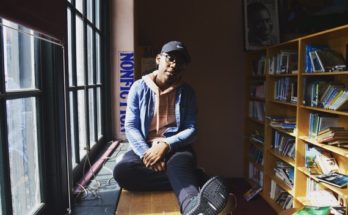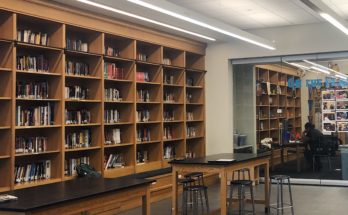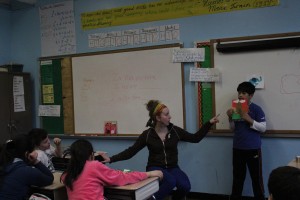
Artist-in-residence Rosemary Taylor stood in front of the a class of 29 sixth graders in Intermediate School 62 in Ditmas Park, Brooklyn one Wednesday afternoon, cutting up a bright piece of paper into an elephant’s leg.
“It looks like boots,” said Taylor, as students looked up from their work momentarily. “Elephant legs kind of look like boots.”
“Likes Uggs,” chimed in Tatiana Helms, the class’s English Language Learner teacher, referring to the popular bulky winter boots.
“What’s Ugg?” asked an Uzbek boy sitting in the front of the class with a thick accent.
“Ugly boots?” guessed another sitting nearby.
The sixth grade students were each making a three-panel collage depicting elephants engaged in various human activities. The project organized by the Urban Arts Partnership’s Story Studio was part of a unique ELL class that teaches language fluency to new immigrant students through the arts.
The studio program is not unique to I.S. 62, also known as Ditmas Junior High School. It is going on in 15 middle schools throughout New York City, targeting in large part South Asian and Spanish-speaking students from Latin and Central America.
What does set this class and this school apart is its large and growing population of white immigrants, Uzbeks. More than a third of approximately 330 ELL students at Ditmas are Uzbek, a number that has increased dramatically in the last three years. Last year, around 90 new Uzbek students enrolled at Ditmas throughout the year forcing the school to open a new sixth, seventh, and eighth grade. This year has seen a relatively lower influx of students.
Uzbek students tend to speak multiple languages — Russian and Tajik in addition to Uzbek. This helps students become receptive to learning a fourth language, English. She finds that the Uzbek language can sometimes take over the classroom because of the numbers of children who speak it.
“They seem open-minded,” said Taylor. “They speak more than one language, so they’re open to kids who speak other languages around them.”
Elzara Celebi, who is Ukrainian but born and raised in Uzbekistan, is the only teacher aide in the school who can understand Uzbek. Most of the students she knows come from the same city in Uzbekistan–Samarkand–and are actually ethnic Tajiks. Many parents told her they were able to immigrate to the U.S through lottery visas. Though she can understand Uzbek, she can’t speak the language and communicates with students and parents in Russian, a language many of them know because their country was once a part of the Soviet Union until its collapse in 1989.
Celebi, who has been working at Ditmas for almost five years, said that while she has no Uzbek students in her classroom, she has been frequently called upon by teachers, guidance counselors, as well as administrators to translate. At the start of the year, she was called three to four times a week to serve as an intermediary between either students and teachers or parents and teachers. As the year progressed, the frequency falls to only twice per week.
One of the biggest challenges Celebi said is dealing with misconceptions Uzbek students have about freedom in America, because their culture is stricter. American classrooms tend to be more informal and resource rich than they expect. Taylor said some Uzbek children come from schools without chairs or desks. Others had never been to school.
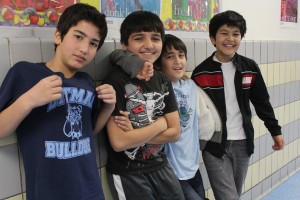
The misconception sometimes leads to behavioral issues. “The kids come to America and they think it’s a free country and they can do anything they want,” Celebi said, adding that they may take their new found freedom for granted. “We call the parents and say ‘yes, it is a free country but there are some rules in school that you have to obey.’”
Irene L. Neri, who has been teaching math at Ditmas for 10 years, said she has learned to communicate class rules early on. She often calls parents at home to discuss their children’s behavior.
Celebi said parents are often surprised to find out their boys may be misbehaving. One sixth grade boy conjectured that normal Uzbek rough housing was being misinterpreted by American children, and perhaps teachers. Fayoz Yodgorov, a sixth grade Uzbek boy said many of his friends have learned not to “play-fight” with students from other countries. “They don’t understand, and they’re going to hit us for real,” Yodgorov said.
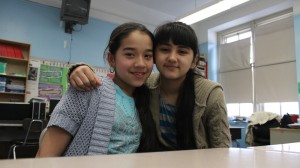
Girls, on the other hand, have adjusted more readily. “The Uzbek girls talk about the Uzbek girls,” said Celebi. This may leads to fights, but amongst themselves.
“There are girls who are so drama queen,” said 12-year-old Mohigul Bakayeva.
Her classmate Farzuna Rahmatova said she worried that the abundance of Uzbek students in Ditmas speaking their native language would prevent her from improving her English.
“But when I came here, it’s the best teachers,” Rahmatova said who has moved into a mainstream class from her English Language Learner class.

